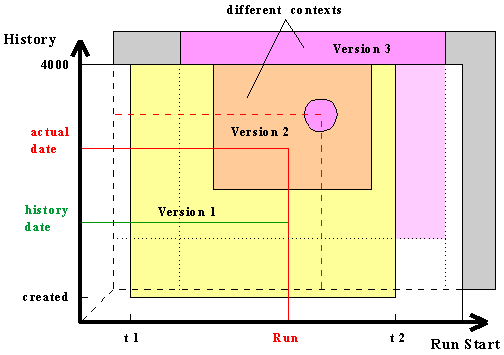You are here: Foswiki>Homepages Web>HadesRtdbOracleInterfaceIlseKoenig (2007-07-01, IlseKoenig)Edit Attach
The Oracle analysis interface
The version management in Oracle
Most parameters used by the analysis change over time and need a version management in Oracle. Some data can have only one valid value at a certain date as for example the position of a certain cable, other ones may even change over time for a certain DAQ run depending on the status of the analysis. The mayor requirements are:- It must be possible to get a consistent set of informations at any date.
- To keep the history, no information, even if it is wrong, should to be overwritten without trace, to get an answer on the questions like this: Which parameters have I used when I did the analysis of these runs six months ago?
- Good performance
- time axis of runs
- time axis of history
- parameter context
| Variable | Description |
|---|---|
| valid_until | Last date when the entry is still valid. (01-JAN-4000 00:00:00 for actual valid version) |
| date_create | Date when a version is inserted |
| invalid_since | Date when the entry is replaced by a new or better version and therefore gets invalid. |
| valid_since | First date when the entry is valid. |
| context_id | Identifier of the parameter context |
Date_create and invalid_since define a time range on the history axis and are set automatically. Example: The user validates at a certain point in time (created on the history axis in the picture below) a version 1 for the time range t1 t2 (valid_since - valid_until) on the runs axis (yellow rectangle).
Date_create is set automatically to the actual date and invalid_since to year 4000 (open end on the history axis).
This version will now be used for initialization of all runs with start times between t1 and t2.
 At a later time, a user insert a new version 2 for the same context and validates it for the time range t3 t4 (orange rectangle), in this example in a smaller time range than the first one.
At a later time, a user insert a new version 2 for the same context and validates it for the time range t3 t4 (orange rectangle), in this example in a smaller time range than the first one.The WebDB validation GUI sets the entry of version 1 invalid by setting invalid_since to the insert date minus 1 second. It then inserts three new rows:
- version 1 in time range t1 until (t3 - 1 second)
- version 2 in time range t3 until t4
- version 1 in time range (t4 + 1 second) until t2
But if the user sets the history date to a time before version 2 was created, all runs will be initialized with version 1. One can define a parameter release for a beam time or a simulation projects. These are (named) timestamps on the history axis.
In the analysis interface the history date is set by default to the time stamp of the last parameter release or to now, if no parameter release exists.
The user may overule this by setting explicitly a history date in the analysis macro. -- IlseKoenig - 01 Jul 2007
Edit | Attach | Print version | History: r1 | Backlinks | View wiki text | Edit wiki text | More topic actions
Topic revision: r1 - 2007-07-01, IlseKoenig
Copyright © by the contributing authors. All material on this collaboration platform is the property of the contributing authors.
Ideas, requests, problems regarding Foswiki Send feedback | Imprint | Privacy Policy (in German)
Ideas, requests, problems regarding Foswiki Send feedback | Imprint | Privacy Policy (in German)
